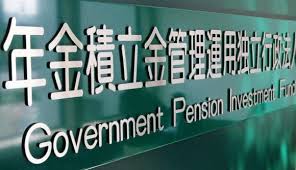
As stocks tumbled and the yen surged, all investment gains since it overhauled its strategy by boosting shares and cutting bonds were wiped out and a $52 billion loss in the last quarter was posted by the world’s biggest pension fund.
Japan’s Government Pension Investment Fund said that its assets were reduced to 129.7 trillion yen and it lost 3.9 percent, or 5.2 trillion yen ($52 billion), in the three months ended June 30. In October 2014, the fund had decided to put half its assets into equities and a 4.1 trillion yen investing return for the previous six quarters starting October 2014 were erased by this loss.
In the worst annual performance since the global financial crisis, the quarterly decline follows a 5.3 trillion yen loss in the fiscal year through March. GPIF has posted losses as domestic stocks tumble and gains in the currency reduce the value of overseas assets after benefiting from a surge in Japanese equities and a weaker yen earlier in Prime Minister Shinzo Abe’s term. That’s no reason to veer from the current approach, said Sumitomo Mitsui Trust Bank Ltd.
“Since its investments are tied to market moves, it’s natural that this would happen and there’s no point looking at it with a short-term view. GPIF is so big that its losses look huge even though the fluctuations in its investments just mirror the market,” said Ayako Sera, a Tokyo-based market strategist at the bank.
As the benchmark Topix index lost 7.5 percent, the fund’s Japanese shares sank 7.4 percent in the period. More than 80 percent of GPIF’s local equity investments are passive. As the yen surged 9.1 percent against the dollar, foreign debt fell 8 percent, while overseas stocks lost 7.8 percent. Domestic bonds, which rose in value as the Bank of Japan’s negative interest rates sent yields lower, was the only asset class to post a profit.
“We invest with a long-term view. Even if market prices fluctuate in the short term, it won’t damage pension beneficiaries. We are also strengthening risk management and continuing to hire experts,” President Norihiro Takahashi said in a statement Friday.
GPIF held 39 percent of investments in domestic bonds and 21 percent of investments in local stocks at the end of June. While foreign debt accounted for 13 percent, overseas equities made up 21 percent of assets. Down from 0.06 percent at the end of March, alternative investments were 0.05 percent of holdings. GPIF targets allocations of 35 percent for local bonds, 15 percent for foreign debt and 25 percent each for Japanese and overseas stocks.
He was more positive about the outlook for returns this quarter GPIF official Shinichiro Mori said in a briefing about the results. The Topix has climbed 3.4 percent since the start of July.
“The U.K.’s decision on Brexit was a surprise for the market, but it has mostly priced that in and calmed down. Stocks are on the verge of rebounding. Still, the yen is continuing to trade sideways against the dollar, so we are cautiously watching that,” Mori said.
(Source:www.bloomberg.com)
Japan’s Government Pension Investment Fund said that its assets were reduced to 129.7 trillion yen and it lost 3.9 percent, or 5.2 trillion yen ($52 billion), in the three months ended June 30. In October 2014, the fund had decided to put half its assets into equities and a 4.1 trillion yen investing return for the previous six quarters starting October 2014 were erased by this loss.
In the worst annual performance since the global financial crisis, the quarterly decline follows a 5.3 trillion yen loss in the fiscal year through March. GPIF has posted losses as domestic stocks tumble and gains in the currency reduce the value of overseas assets after benefiting from a surge in Japanese equities and a weaker yen earlier in Prime Minister Shinzo Abe’s term. That’s no reason to veer from the current approach, said Sumitomo Mitsui Trust Bank Ltd.
“Since its investments are tied to market moves, it’s natural that this would happen and there’s no point looking at it with a short-term view. GPIF is so big that its losses look huge even though the fluctuations in its investments just mirror the market,” said Ayako Sera, a Tokyo-based market strategist at the bank.
As the benchmark Topix index lost 7.5 percent, the fund’s Japanese shares sank 7.4 percent in the period. More than 80 percent of GPIF’s local equity investments are passive. As the yen surged 9.1 percent against the dollar, foreign debt fell 8 percent, while overseas stocks lost 7.8 percent. Domestic bonds, which rose in value as the Bank of Japan’s negative interest rates sent yields lower, was the only asset class to post a profit.
“We invest with a long-term view. Even if market prices fluctuate in the short term, it won’t damage pension beneficiaries. We are also strengthening risk management and continuing to hire experts,” President Norihiro Takahashi said in a statement Friday.
GPIF held 39 percent of investments in domestic bonds and 21 percent of investments in local stocks at the end of June. While foreign debt accounted for 13 percent, overseas equities made up 21 percent of assets. Down from 0.06 percent at the end of March, alternative investments were 0.05 percent of holdings. GPIF targets allocations of 35 percent for local bonds, 15 percent for foreign debt and 25 percent each for Japanese and overseas stocks.
He was more positive about the outlook for returns this quarter GPIF official Shinichiro Mori said in a briefing about the results. The Topix has climbed 3.4 percent since the start of July.
“The U.K.’s decision on Brexit was a surprise for the market, but it has mostly priced that in and calmed down. Stocks are on the verge of rebounding. Still, the yen is continuing to trade sideways against the dollar, so we are cautiously watching that,” Mori said.
(Source:www.bloomberg.com)





